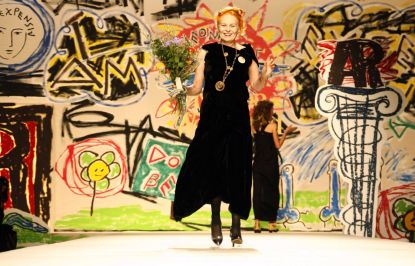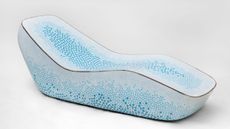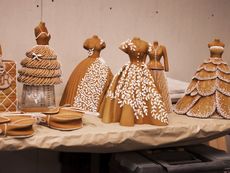In memoriam: Vivienne Westwood (1941 – 2022)
We remember iconoclastic British fashion designer Dame Vivienne Westwood, who has died aged 81
- (opens in new tab)
- (opens in new tab)
- (opens in new tab)
- Sign up to our newsletter Newsletter

Iconoclastic British fashion designer Dame Vivienne Westwood, who rose to prominence during the punk movement of the 1970s and has remained an anarchic presence in fashion since, has died aged 81.
Announced yesterday evening (29 December 2022), Westwood died peacefully surrounded by friends and family in her home in Clapham, South London. Andreas Kronthaler, Westwood’s husband and creative partner, paid tribute: ‘I will continue with Vivienne in my heart. We have been working until the end and she has given me plenty of things to get on with. Thank you darling.’
Westwood continued to ‘do the things she loved up until the last moment, designing, working on her art, writing her book, and changing the world,’ the statement continued. It also noted that Westwood considered herself a Taoist, an ancient Chinese philosophy which encourages harmony with the universe.
Dame Vivienne Westwood dies aged 81

Vivienne Westwood with Malcolm McLaren in 1977
‘There was never more need for the Tao than today,’ Westwood is quoted as previously saying. ’Tao gives you a feeling that you belong to the cosmos and gives purpose to your life; it gives you such a sense of identity and strength to know you’re living the life you can live and therefore ought to be living: make full use of your character and full use of your life on Earth.’
Westwood was born Vivienne Isabel Swire in 1941 in the small village of Tintwistle, Derbyshire, before moving to the north London suburb of Harrow with her family in 1957. She briefly attended Harrow Art School, dropping out after a term to attend secretarial college and later become a teacher. She married Derek Westwood in 1962 and gave birth to her first child Benjamin Westwood in 1963, though they split not long afterwards.
It was while working as a primary school teacher that Westwood met then-art student Malcolm McLaren – a music impresario who went on to manage the Sex Pistols – in a relationship that would prove formative. Part of London’s burgeoning punk movement, they opened the boutique Let It Rock at 430 King’s Road in 1971, selling vintage memorabilia and clothing. It would undergo various iterations in the following years – Too Fast To Live Too Young To Die, SEX, Seditionaries and finally Worlds End – incorporating Westwood and McLaren’s own designs, which often featured provocative slogans and DIY construction. Other pieces were inspired by fetish wear.

Vivienne Westwood and Malcolm McLaren’s ‘Pirates’ collection in 1981
In 1981, Westwood and McLaren staged their first runway show ‘Pirates’, which marked a shift from punk and ushered in the New Romantics era (Adam Ant had drafted McLaren for a rebrand not long earlier; several of the designs came from outfits created for the musician). Drawing inspiration from historical portraiture of the 17th and 18th centuries, romantic flourishes – bell sleeves, pirate hats, sashes and powdered wigs – met the anarchic spirit of their previous work with studded and tattered elements.
Such a dichotomy continued to run through Westwood’s collections throughout her career (the partnership with McLaren was dissolved in the mid-1980s). In 1985, she introduced the ‘mini crini’ – a thigh-grazing riff on historical crinolines – and later reintroduced the corset, worn exposed, in 1987 (versions of the corset have appeared in Westwood collections ever since). Such inspirations were oftentimes drawn from a collection of artists she particularly admired – Jean-Honoré Fragonard, François Boucher and Thomas Gainsborough – noting her particular fondness for London’s The Wallace Collection gallery and its Rococo portraiture.
Tropes of traditional British dress would also be an inspiration point for the designer, most famously in her evocation of tartan. Presented in Paris, Westwood’s A/W 1993 collection was titled Anglomania and featured ‘MacAndreas’ tartan – named after husband Kronthaler – across a collection that the designer said was about English tailoring and ‘country charm’ through a French lens.

Vivienne Westwood A/W 1993 ‘Anglomania’ collection
‘On the English side we have tailoring and an easy charm, on the French side that solidity of design and proportion that comes from never being satisfied because something can always be done to make it better, more refined,’ she said. The show was also notable for one of Westwood’s most notable moments, Naomi Campbell’s catwalk tumble in a towering pair of ‘Elevated Ghillie’ heels.
Throughout the 1990s and into the 2000s, Westwood would become one of British fashion’s most notable exports. In 1996, Vivienne Westwood MAN launched with a show in Milan; in 1998, Anglomania became its own diffusion line; while boutiques opened worldwide, from New York to Tokyo. In 2004, Westwood was celebrated with an exhibition at London’s V&A Museum titled ‘Vivienne Westwood: 34 Years in Fashion’, which was then the largest-ever exhibition dedicated to a British designer. Having been made an Officer of the Order of the British Empire (OBE) in 1992, she was late made a Dame in 2006.
Westwood remained an avid activist throughout her life, pioneering ethical and sustainable production with her collections, and supporting numerous causes, NGOs and charities – from Greenpeace to the Humane Society International, which attempts to prevent sales of fur in the UK. In 2012 at the London Paralympics closing ceremony, she began Climate Revolution which aims to unite various organisations in the pursuit of preserving the planet for generations ahead. ‘I want you to help me save the world, I can’t do it on my own,’ she said.

Vivienne Westwood at a demonstration ahead of her S/S 2016 show
Later in life, she took an increasingly anti-establishment approach, denouncing over-consumption and capitalism – which she called ‘the root of war, climate change and corruption’ – and taking part in numerous protests. One particular cause was support for WikiLeaks founder Julian Assange. Dressing as a yellow ‘canary’ she stood in a cage outside the Old Bailey court in 2020, protesting against Assange’s extradition from Britain to the United States.
These pursuits will continue with the advent of The Vivienne Foundation, announced yesterday, which will run under four pillars – climate change, stop war, defend human rights, and protest capitalism.
Kronthaler, who took over the Gold Label in 2016 – since renamed ‘Andreas Kronthaler for Vivienne Westwood’ – will continue to show collections seasonally in Paris. ‘Vivienne still has the same bite and energy,’ he told The Guardian in 2021, ’although just a little slower. But I still rely on her totally: she’s the only person I trust to say when something is good, the only adviser and guide I can follow.
’She [articulates] ideas I’ve not even had yet. About fashion, yes, but more than that: a way to look at life.’
Jack Moss is the Fashion Features Editor at Wallpaper*. Having previously held roles at 10, 10 Men and AnOther magazines, he joined the team in 2022. His work has a particular focus on the moments where fashion and style intersect with other creative disciplines – among them art and design – as well as championing a new generation of international talent and profiling the industry’s leading figures and brands.
-
 Men’s engagement rings for modern grooms
Men’s engagement rings for modern groomsMen’s engagement rings, whether classic or colourful, make for sentimental tokens
By Hannah Silver • Published
-
 Longchamp unites with D’heygere on a playful collection made to ‘transform the everyday’
Longchamp unites with D’heygere on a playful collection made to ‘transform the everyday’Inspired by Longchamp’s foldaway ‘Le Pliage’ bag, this collaboration with Paris-based jewellery and accessories designer Stéphanie D’heygere sees pieces that ‘transform and adapt’ to their wearer
By Jack Moss • Published
-
 Last chance to see: Marc Newson’s all-blue designs in Athens
Last chance to see: Marc Newson’s all-blue designs in AthensGagosian gallery Athens presents new blue furniture and objects by Marc Newson
By Rosa Bertoli • Published
-
 The making of Dior’s spectacular festive Harrods takeover
The making of Dior’s spectacular festive Harrods takeoverLook behind the scenes as London’s Harrods is transformed into a gingerbread-filled wonderland by Dior
By Jack Moss • Published
-
 This winter’s most stylish skiwear, Gucci to Hermès
This winter’s most stylish skiwear, Gucci to HermèsStatement-making skiwear for on and off the slopes, from Louis Vuitton, Dior, Moncler and more
By Jack Moss • Published
-
 Recreate Chanel Beauty looks from the pages of Wallpaper* with this make-up how-to
Recreate Chanel Beauty looks from the pages of Wallpaper* with this make-up how-toMake-up artist Anna Payne teaches you how to get the looks from Wallpaper’s latest Chanel Beauty photoshoot
By Mary Cleary • Published
-
 Step into the greatest fashion stores around the world
Step into the greatest fashion stores around the worldA virtual tour of the world’s finest fashion stores, from London to Tokyo, Atlanta to Shanghai
By Jack Moss • Published
-
 Birkenstock ‘Bold’ reimagines the brand’s classic shoes in warm shearling
Birkenstock ‘Bold’ reimagines the brand’s classic shoes in warm shearlingThe new Birkenstock ‘Bold’ collection celebrates craftsmanship in a launch campaign that teams its shearling-lined shoes with works by California-based artist Vince Skelly
By Martha Elliott • Published
-
 The definitive packing list for every trip
The definitive packing list for every tripThe Wallpaper* packing list – from weekends away to long-haul trips further afield, our comprehensive guide to filling up your carry-on
By Mary Cleary • Published
-
 The finest fashion books for style enthusiasts
The finest fashion books for style enthusiastsThe fashion books taking pride of place on the Wallpaper* style desk. From monographs and photographic tomes to limited-edition titles, we explore the latest releases
By Jack Moss • Published
-
 How Virgil Abloh’s legacy lives on through collaboration
How Virgil Abloh’s legacy lives on through collaborationA year on from his death, a slew of collaborations continue to bear Virgil Abloh’s name – a testament to the enduring legacy of the polymathic designer whose curiosity spanned disciplines
By Jack Moss • Published










